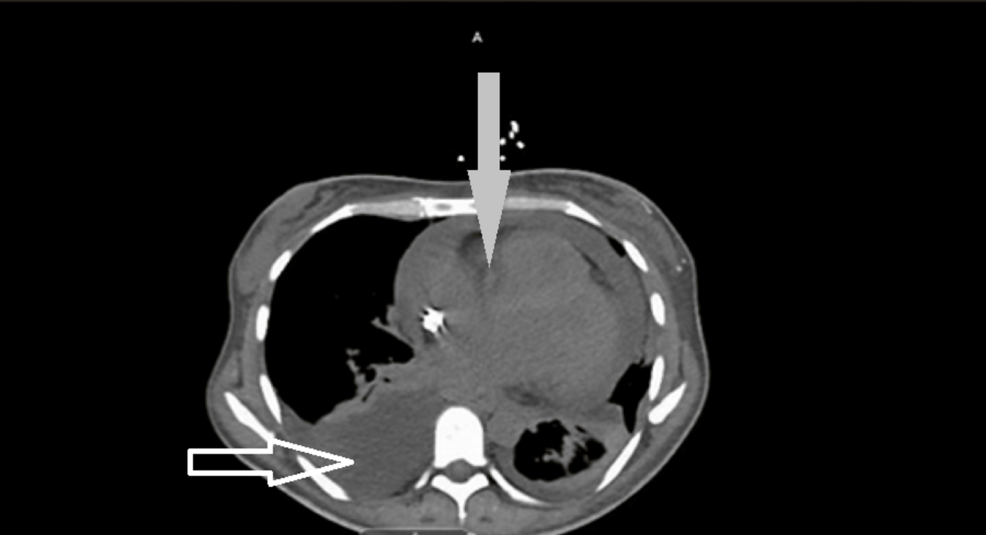Aisyah Shofiatun Nisa, Hadi Susiarno, Gatot Nyarumenteng Adipurnawan Winarno, Putri Nadhira Adinda Adriansyah
Department of Obstetrics and Gynecology, Faculty of Medicine, Universitas Padjadjaran – Dr. Hasan Sadikin General Hospital, Bandung, Indonesia
Correspondence: Aisyah Shofiatun Nisa, Department of Obstetrics and Gynecology, Faculty of Medicine, Universitas Padjadjaran – Dr. Hasan Sadikin Hospital, Jl. Pasteur 38, Bandung, West Java, 40161, Indonesia, Email [email protected]
Introduction
Hydrops Fetalis refers to a condition in which the fetus has excessive fluid accumulation within the fetal extra vascular compartments and body cavities; this is typically characterized by skin thickness greater than 5 mm (skin edema), placental enlargement, pericardial or pleural effusion, and ascites.1,2 Hydrops Fetalis is divided into 2 categories: immune hydrops fetalis (IHF) and non-immune hydrops fetalis (NIHF).3 NIHF specifically refers to cases not associated with maternal antibody reactions against fetal red blood cell antigens. The incidence of NIHF occurs in 1 out of 1700–3000 pregnancies, with live birth rates of 1 in 4000 pregnancies.1,4 The majority of NIHF cases are related to intrauterine fetal death. The main causes of NIHF are fetal cardiovascular problems, idiopathic, and lymphatic dysplasia.2
The etiologies of NIHF are diverse, with the most common causes including fetal cardiovascular anomalies, idiopathic origins, and lymphatic dysplasia.5 Among fetal cardiovascular conditions, congenital heart disease (CHD) is a leading contributor. CHD is the most frequently occurring congenital anomaly globally, affecting approximately 4 to 12 out of every 1000 live births.6–8 CHD is a major contributor to infant mortality. One of the risk factors linked to CHD is maternal alcohol consumption prior to pregnancy. More than 40% of adults worldwide consume alcohol, and over 50% of women of childbearing age consume alcohol at varying levels.9,10 Interestingly, 51% of pregnancies are unplanned, and pregnancy often becomes known only around weeks 5–6. Prenatal alcohol exposure (PAE) is believed to be a key factor influencing the teratogenic process in heart development, ultimately affecting the heart’s septum, valves, chambers, arteries, and heart pathways.11,12 This case report aims to present a rare case of non-immune hydrops fetalis in a fetus from a mother with a history of heavy alcohol consumption, without any underlying hematologic disorders. This case emphasizes the need for improved prenatal counseling and awareness of modifiable risk factors that may contribute to fetal morbidity and mortality.
Case Illustration
A woman in her early 30s presented to the emergency department with the chief complaint of not feeling fetal movements for one day prior to admission. She estimated her pregnancy to be at six months but was unable to recall the date of her last menstrual period. This was her fourth pregnancy, with no history of miscarriage or abortion. The patient reported a history of smoking two packs of cigarettes daily and regular alcohol consumption. She reported consuming approximately 620–1860 mL of alcohol daily (around 2–3 bottles per day) with an alcohol concentration of approximately 14.7%, beginning at least three months prior to conception and continuing throughout the pregnancy. Based on the duration and volume of intake, this pattern meets the clinical criteria for chronic alcohol use. She denied any family history of blood disorders, infections, chromosomal abnormalities, or congenital anomalies, and she had no personal history of similar conditions. Her vital signs were within normal limits.
Physical examination revealed the absence of a fetal heart rate and uterine contractions. Laboratory results showed an elevated fibrinogen level (> 400 mg/dL), while other parameters were within normal ranges. Ultrasonography (USG) indicated a single intrauterine fetus with no signs of life, corresponding to a gestational age of 27 weeks (Figure 1). The estimated fetal weight is 1148 grams (35th percentile), with a negative fetal heart pulsation. Mild scalp edema is present, measuring 0.62×0.63×0.70 cm. Subcutaneous edema is present, measuring 0.61×0.60×0.62 cm. Based on these findings, fetal hydrops was suspected and pregnancy termination was initiated using misoprostol.
|
Figure 1 Ultrasound examination results upon the patient’s arrival at the Emergency Department (ED), indicating fetal hydrops with fluid accumulation in the brain and abdomen. (A) Ultrasound image of the fetal head shown scalp edema (red arrow). (B) Ultrasound image of the fetal abdomen shown excess fluid within the abdomen. Red arrow shown the subcutaneous edema within the abdomen.
|
The baby was delivered four hours after the first dose of misoprostol. The newborn weighed 1755 grams and measured 44 cm in length, with grade 2 maceration and no signs of life. Examination revealed fluid accumulation in the chest and body, consistent with a diagnosis of fetal hydrops (Figure 2). The patient had not undergone an ultrasound examination earlier in the pregnancy, as her antenatal care was limited to visits with a midwife. The placenta was delivered intact and weighed 500 grams, which is larger than normal (Figure 3). The findings of placentomegaly and abnormalities in the placenta’s structure are significant in the context of Non-Immune Hydrops Fetalis (NIHF). These observations support the pathological process of fluid accumulation and placental dysfunction, which are hallmark features of NIHF. The enlarged placenta reflects underlying fetal cardiovascular compromise and systemic congestion, often associated with prenatal alcohol exposure and other contributing factors in this case.
 |
Figure 2 Clinical presentation of a neonate diagnosed with Hydrops Fetalis.
|
 |
Figure 3 (A) Maternal surface of the placenta, showing a coarse and vascularized appearance. (B) Fetal surface of the placenta, highlighting the translucent membrane and visible vasculature. (C) Close-up view of the umbilical cord, showing the blood vessels. (D) Measurement of the placenta’s weight, approximately 500 grams, indicating placentomegaly.
|
Discussion
Prenatal alcohol exposure (PAE) has been associated with various adverse fetal outcomes, including congenital heart defects (CHD), which may contribute to the development of non-immune hydrops fetalis (NIHF).13 NIHF has an incidence of 1 in 1700–3000 pregnancies.4 This condition can affect maternal health by causing polyhydramnios, malpresentation, and premature birth. Meta-analyses conducted by Bellini et al categorized the causes of NIHF into 14 categories, with the highest contributor being cardiovascular system abnormalities.2 Cardiovascular disorders leading to NIHF are divided into 4 categories: structural heart disease, cardiomyopathies, fetal arrhythmias, and vascular disorders.3 The presence of congenital heart disease can lead to both structural and vascular disturbances, hence congenital heart disease is often associated with NIHF occurrences.3 PAE is considered a key factor causing CHD.14 Alcohol consumption has been widespread globally and has increased in usage across the world. According to the WHO, around 47.2 billion liters of pure alcohol were consumed in 2015.15
In this case, the patient presented with Intrauterine Fetal Demise (IUFD) without any prior ultrasound examination. Upon further questioning, the patient denied any history of blood disorders, multiple pregnancies, or other significant illnesses. However, she disclosed a history of alcohol consumption, typically consuming 2–3 bottles daily. The exact concentration and type of alcohol could not be determined, as the patient frequently changed brands. Most commonly, she consumed alcohol with an approximate concentration of 14.7%, in quantities ranging from 620 mL to 1860 mL per day. At delivery, the baby was born lifeless, exhibiting signs of skin edema, as shown in Figure 2. The Department of Pediatrics subsequently diagnosed the fetus with hydrops fetalis.
In normal non-pregnant women, the fibrinogen level ranges between 200–400 mg/dL. However, during pregnancy, fibrinogen levels can increase by up to 50%, and in the late trimester of pregnancy, fibrinogen levels can range between 300–600 mg/dL. The increase in fibrinogen levels in this case is not a basis for the occurrence of hydrops fetalis.16,17
While PAE is a plausible contributing factor in this case, other potential etiologies such as intrauterine infection, chromosomal or genetic abnormalities, and fetal anemia must also be considered. The lack of a fetal autopsy and advanced genetic testing limits our ability to exclude these possibilities.18 This highlights the need for comprehensive diagnostic evaluation in future similar cases.
In certain instances of hydrops fetalis, placentomegaly and polyhydramnios may be observed, although they are not included in the diagnostic criteria.19 The placenta at full term pregnancy has a disc-like shape and is of a dark red color, weighing between 500 to 600 grams. The growth and development of the fetus during pregnancy heavily depend on the vascular supply from the uteroplacental. In cases of hydrops fetalis, the placenta’s size tends to be larger than the normal size called placentomegaly.20 The birth weight to placental weight ratio is often used as an indicator of placental efficiency. In several cohort studies, birth weight has been found to be 5–7 times greater than placental weight during pregnancy.21–23 In this case, the birth weight is 1700 grams while the placental weight is 500 grams. This demonstrates a larger placental size compared to its normal size.
The patient does not have any risk factors that could lead to hydrops fetalis during pregnancy. The patient denies having a history of similar pregnancies, blood disorders, or infections. However, we cannot diagnose a CHD in the fetus either, as the patient did not undergo the necessary antenatal examinations as she should have. The only potential risk factor that could contribute to hydrops fetalis in this case is alcohol consumption prior to and during pregnancy. The mechanism of PEA lead to NIHF was described in Figure 4.
 |
Figure 4 Mechanism by which Prenatal Alcohol Exposure (PAE) contributes to Non-Immune Hydrops Fetalis (NIHF).
Abbreviations: NIHF, Non-immune hydrops Fetalis; HATs, Histone Acetyltransferases; ERK 1/2, Extracellular signal-Regulated Kinases 1 and 2; BMP, Bone Morphogenetic Protein; Klf-2a, Krüppel-like factor 2a.
|
Figure 4 shown the diagram of causes in case of Prenatal Alcohol Exposure (PAE) contributes to the development of Non-Immune Hydrops Fetalis (NIHF) through a multifactorial mechanism that impacts fetal cardiovascular health and fluid balance. PAE induces hyperactivity of histone acetyltransferases (HATs), leading to epigenetic changes that disrupt normal gene expression. Additionally, PAE enhances ERK 1/2 phosphorylation and causes vitamin A deficiency, which are crucial for proper fetal development. It also reduces Wnt transcription activity mediated by internal calcium, impairs bone morphogenetic protein (BMP) signaling in cardiac chamber cells, and decreases the activity of Notch signaling pathways. These disruptions collectively interfere with the transcription of klf-2a, a critical factor in cardiac development.24–26
HATs play a crucial role in activation, transcription, cell cycle, and epigenetic regulation of mesenchymal stem cells into cardiomyocytes. Disruption in the balance of HATs can interfere with heart development by inducing H3K9 hyperacetylation.24–26 Additionally, alcohol exposure increases the phosphorylation of extracellular signal-regulated kinase (ERK)1/2, inducing the overexpression of Gata4 and Mef2c in alcohol-cultured h9c2 cells to participate in CHD development.27–29 Genetic variations in Gata4 can lead to CHDs such as ASD, VSD, and TOF.29 Ethanol exposure can also induce Vitamin A deficiency, which can impact embryonic gene expression.30
The relationship between PEA and CHD can be illustrated through seven main theories: hyperactivity of histone acetyltransferases (HATs), increased extracellular signal-regulated kinase (ERK)1/2 phosphorylation, induction of Vitamin A deficiency, spatial-temporal control of Wnt signaling, hyperactivity of BMP in chamber cells, reduction of active Notch cells, and transcription of the Klf-2a factor.12 As a result, these abnormalities contribute to the development of congenital heart disease, including both structural heart defects and vascular disorders. Such cardiovascular abnormalities lead to cardiac failure, which increases central venous pressure and promotes the accumulation of interstitial fluid.31 The excessive buildup of fluid in the fetal body ultimately manifests as NIHF. This cascade underscores the complex interplay between prenatal environmental factors, such as alcohol exposure, and their detrimental impact on fetal health, emphasizing the importance of preventive care and early monitoring during pregnancy.
According to research by Parnell et al, structural brain abnormalities caused by ethanol exposure were found to vary depending on the stage of gestation. Exposure to ethanol during gestational days (GD) 7–11 led to a notable decrease in cerebellar volume and an increase in septal volume. In contrast, ethanol exposure during GD 12–16 was associated with a reduction in right hippocampal volume and enlarged pituitary glands. Furthermore, ethanol exposure during GD 12–16 was linked to a high occurrence of edema or fetal hydrops.32
Apoptosis and disturbances in CNCC function are common causes of CHDs.33 Several studies have revealed that alcohol can affect the Wntβ-catenin signaling pathway, which functions in normal gene activation and cardiogenesis.34 BMP signaling is necessary for heart specification, endocardial differentiation, chamber morphogenesis, heart looping, and OFT septation. Meanwhile, PEA can influence BMP activity from cardiomyocytes.35 Notch signaling is crucial in endocardium differentiation, epicardial cell interactions, cardiac looping, and OFT development during embryogenesis. Alcohol exposure, on the other hand, can reduce Notch cell activity.36 Klf2a plays an important role in valvulogenesis and heart chamber development, while PEA can affect Klf2a expression, potentially leading to CHDs, which often involve valve disturbances.37 CHD can cause impaired blood flow or blood flow obstruction, leading to increased pressure within capillaries and veins. This increased pressure can disrupt the balance between intravascular blood flow and interstitial fluid, ultimately contributing to the accumulation of fluid within fetal body cavities.
Ultimately, this case underscores the complex interplay between prenatal environmental factors, such as alcohol exposure, and fetal cardiovascular compromise. It highlights the importance of early prenatal screening, comprehensive maternal counseling, and thorough diagnostic workup to assess for possible infections, genetic anomalies, and hematologic conditions in cases of NIHF.
This case report has several strengths. It presents a rare and clinically relevant instance of non-immune hydrops fetalis (NIHF) potentially associated with prenatal alcohol exposure, contributing valuable insight into a less frequently reported etiology. The detailed maternal history, including lifestyle factors such as smoking and alcohol consumption, combined with clinical, ultrasonographic, and placental findings, provides a comprehensive view of the case. Furthermore, the discussion integrates current evidence on the molecular and epigenetic mechanisms through which alcohol may contribute to congenital heart disease and NIHF, adding scientific depth and relevance. However, the case also has notable limitations. The absence of early antenatal care and ultrasound examination limits the ability to confirm gestational age accurately and detect fetal anomalies earlier in the pregnancy. The patient’s inability to recall her last menstrual period further complicates pregnancy dating and assessment of fetal growth. Additionally, no fetal autopsy or genetic testing was performed, restricting definitive conclusions regarding the underlying cause of hydrops fetalis and the exclusion of chromosomal or structural abnormalities. Lastly, the history of alcohol consumption was based solely on patient self-reporting, without objective confirmation, which may affect the accuracy of exposure assessment.
Conclusion
The development of hydrops fetalis in this case is suspected to be associated with maternal alcohol consumption prior to conception, which may have disrupted fetal development through teratogenic mechanisms. This case highlights the significant impact of maternal lifestyle choices, particularly alcohol and tobacco use, on fetal health. These factors may contribute to intrauterine growth restriction, placental insufficiency, and fetal hypoxia. Hydrops fetalis, characterized by fluid accumulation in multiple fetal compartments, can result from various underlying conditions such as fetal anemia, congenital infections, or chromosomal abnormalities. Comprehensive and routine prenatal assessments are essential for early detection of fetal abnormalities, monitoring growth parameters, and identifying risk factors that may affect pregnancy outcomes. The delayed maternal recognition of absent fetal movement emphasizes the importance of antenatal education to increase awareness of fetal well-being. In addition, further diagnostic evaluations including fetal autopsy and genetic analysis are recommended to determine the underlying cause of hydrops fetalis and to guide management and counseling in future pregnancies.
Informed Consent Patient Statement
No formal ethical clearance was required for the publication of this case. The authors confirm that written informed consent for publication of this case report and any accompanying images was obtained from the patient and her spouse. The patient was informed in detail about the case content and agreed to its publication. All personal identifiers have been removed to ensure patient anonymity.
Disclosure
The authors report no conflicts of interest in this work.
References
1. Norton ME, Chauhan SP, Dashe JS; Society for Maternal-Fetal Medicine (SMFM). Society for maternal-fetal medicine (SMFM) clinical guideline# 7: nonimmune hydrops fetalis. Am J Clin Exp Obstet Gynecol. 2015;212:127–139. doi:10.1016/j.ajog.2014.12.018
2. Bellini C, Donarini G, Paladini D, et al. Etiology of non-immune hydrops fetalis: an update. Am J Med Genet A. 2015;167:1082–1088. doi:10.1002/ajmg.a.36988
3. Swearingen C, Colvin ZA, Leuthner SR. Nonimmune hydrops fetalis. Clin Perinatol. 2020;47:105–121. doi:10.1016/j.clp.2019.10.001
4. Steurer MA, Peyvandi S, Baer RJ, et al. Epidemiology of live born infants with nonimmune hydrops fetalis—insights from a population-based dataset. J Pediatr. 2017;187:182–8.e3. doi:10.1016/j.jpeds.2017.04.025
5. Sparks TN, Thao K, Lianoglou BR, et al. Nonimmune hydrops fetalis: identifying the underlying genetic etiology. Genet Med. 2019;21:1339–1344. doi:10.1038/s41436-018-0352-6
6. Egbe A, Uppu S, Stroustrup A, Lee S, Ho D, Srivastava S. Incidences and sociodemographics of specific congenital heart diseases in the United States of America: an evaluation of hospital discharge diagnoses. Pediatr Cardiol. 2014;35:975–982. doi:10.1007/s00246-014-0884-8
7. Hoffman JI, Kaplan S. The incidence of congenital heart disease. J Am Coll Cardiol. 2002;39:1890–1900. doi:10.1016/S0735-1097(02)01886-7
8. Simeone RM, Oster ME, Cassell CH, Armour BS, Gray DT, Honein MA. Pediatric inpatient hospital resource use for congenital heart defects. Birth Defects Res A. 2014;100:934–943. doi:10.1002/bdra.23262
9. Zegkos T, Ntiloudi D, Giannakoulas G. Parental Alcohol Exposure and Congenital Heart Diseases in Offspring: A Causal Link with Controversial Evidence. London, England: SAGE Publications Sage UK; 2020:407–409.
10. Nakhoul MR, Seif KE, Haddad N, Haddad GE. Fetal alcohol exposure: the common toll. J Alcohol Drug Depend. 2017;5. doi:10.4172/2329-6488.1000257
11. Binkhorst M, Wortmann S, Funke S, Kozicz T, Wevers R, Morava E. Glycosylation defects underlying fetal alcohol spectrum disorder: a novel pathogenetic model: “When the wine goes in, strange things come out”–ST Coleridge, The Piccolomini. J Inherit Metabol Disease. 2012;35:399–405. doi:10.1007/s10545-011-9425-2
12. Chen Z, Li S, Guo L, Peng X, Liu Y. Prenatal alcohol exposure induced congenital heart diseases: from bench to bedside. Birth Defects Res. 2021;113:521–534. doi:10.1002/bdr2.1743
13. Yang J, Qiu H, Qu P, Zhang R, Zeng L, Yan H. Prenatal alcohol exposure and congenital heart defects: a meta-analysis. PLoS One. 2015;10:e0130681. doi:10.1371/journal.pone.0130681
14. Harvey DC, Baer RJ, Bandoli G, Chambers CD, Jelliffe‐Pawlowski LL, Kumar SR. Association of alcohol use diagnostic codes in pregnancy and offspring conotruncal and endocardial cushion heart defects. J Am Heart Assoc. 2022;11:e022175. doi:10.1161/JAHA.121.022175
15. World Health Organization. Global Status Report on Alcohol and Health 2018. World Health Organization; 2019.
16. Atallah A, Piccin G, Dubernard G, Abdul‐Hay MJ, Cortet M, Huissoud C. Fibrinogen for the prediction of severe maternal complications in placental abruption with fetal death after 24 weeks of gestation. Int J Gynecol Obstet. 2023;160:900–905. doi:10.1002/ijgo.14417
17. Murray EK, Murphy MS, Smith GN, Graham CH, Othman M. Thromboelastographic analysis of haemostasis in preeclamptic and normotensive pregnant women. Blood Coagul Fibrinolysis. 2018;29:567–572. doi:10.1097/MBC.0000000000000759
18. Anghelina L, Şerbănescu MS, Stănescu GL, Gheonea C, Stănescu MR, Siminel MA. Nonimmune hydrops fetalis diagnosed at 35 weeks gestation – a case report. Rom J Morphol Embryol. 2024;65:537–541. doi:10.47162/RJME.65.3.17
19. Khairudin D, Alfirevic Z, Mone F, Navaratnam K. Non-immune hydrops fetalis: a practical guide for obstetricians. Obstet Gynaecol. 2023;25:110–120. doi:10.1111/tog.12862
20. Mardy AH, Chetty SP, Norton ME, Sparks TN. A system‐based approach to the genetic etiologies of non‐immune hydrops fetalis. Prenatal Diagn. 2019;39:732–750. doi:10.1002/pd.5479
21. Burkhardt T, Schäffer L, Schneider C, Zimmermann R, Kurmanavicius J. Reference values for the weight of freshly delivered term placentas and for placental weight–birth weight ratios. Eur J Obstetrics Gynecol Reprod Biol. 2006;128:248–252. doi:10.1016/j.ejogrb.2005.10.032
22. Almog B, Shehata F, Aljabri S, Levin I, Shalom-Paz E, Shrim A. Placenta weight percentile curves for singleton and twins deliveries. Placenta. 2011;32:58–62. doi:10.1016/j.placenta.2010.10.008
23. Wallace J, Bhattacharya S, Horgan G. Gestational age, gender and parity specific centile charts for placental weight for singleton deliveries in Aberdeen, UK. Placenta. 2013;34:269–274. doi:10.1016/j.placenta.2012.12.007
24. Carrozza MJ, Utley RT, Workman JL, Cote J. The diverse functions of histone acetyltransferase complexes. Trends Genet. 2003;19:321–329. doi:10.1016/S0168-9525(03)00115-X
25. Choudhury M, Shukla SD. Surrogate alcohols and their metabolites modify histone H3 acetylation: involvement of histone acetyl transferase and histone deacetylase. Alcoholism. 2008;32:829–839. doi:10.1111/j.1530-0277.2008.00630.x
26. Zhong L, Zhu J, Lv T, et al. Ethanol and its metabolites induce histone lysine 9 acetylation and an alteration of the expression of heart development-related genes in cardiac progenitor cells. Cardiovasc Toxicol. 2010;10:268–274. doi:10.1007/s12012-010-9081-z
27. Gao W, Pan B, Liu L, Huang X, Liu Z, Tian J. Alcohol exposure increases the expression of cardiac transcription factors through ERK1/2-mediated histone3 hyperacetylation in H9c2 cells. Biochem Biophys Res Commun. 2015;466:670–675. doi:10.1016/j.bbrc.2015.09.090
28. Pan B, Zhu J, Lv T, Sun H, Huang X, Tian J. Alcohol consumption during gestation causes histone3 lysine9 hyperacetylation and an alternation of expression of heart development‐related genes in mice. Alcoholism. 2014;38:2396–2402. doi:10.1111/acer.12518
29. Mattapally S, Nizamuddin S, Murthy KS, Thangaraj K, Banerjee SK. c. 620C> T mutation in GATA4 is associated with congenital heart disease in South India. BMC Med Genet. 2015;16:1–12. doi:10.1186/s12881-015-0152-7
30. Yelin R, Schyr RB-H, Kot H, et al. Ethanol exposure affects gene expression in the embryonic organizer and reduces retinoic acid levels. Dev Biol. 2005;279:193–204. doi:10.1016/j.ydbio.2004.12.014
31. Ninh VK, El Hajj EC, Mouton AJ, Gardner JD. Prenatal alcohol exposure causes adverse cardiac extracellular matrix changes and dysfunction in neonatal mice. Cardiovasc Toxicol. 2019;19:389–400. doi:10.1007/s12012-018-09503-8
32. Parnell SE, Holloway HE, Baker LK, Styner MA, Sulik KK. Dysmorphogenic effects of first trimester-equivalent ethanol exposure in mice: a magnetic resonance microscopy-based study. Alcohol Clin Exp Res. 2014;38:2008–2014. doi:10.1111/acer.12464
33. Plein A, Fantin A, Ruhrberg C. Neural crest cells in cardiovascular development. Curr Top Dev Biol. 2015;111:183–200.
34. Serrano M, Han M, Brinez P, Linask KK. Fetal alcohol syndrome: cardiac birth defects in mice and prevention with folate. Am J Clin Exp Obstet Gynecol. 2010;203:75.e7–.e15. doi:10.1016/j.ajog.2010.03.017
35. Palencia-Desai S, Rost MS, Schumacher JA, et al. Myocardium and BMP signaling are required for endocardial differentiation. Development. 2015;142:2304–2315. doi:10.1242/dev.118687
36. High FA, Epstein JA. The multifaceted role of Notch in cardiac development and disease. Nat Rev Genet. 2008;9:49–61. doi:10.1038/nrg2279
37. Vermot J, Forouhar AS, Liebling M, et al. Reversing blood flows act through klf2a to ensure normal valvulogenesis in the developing heart. PLoS Biol. 2009;7:e1000246. doi:10.1371/journal.pbio.1000246














